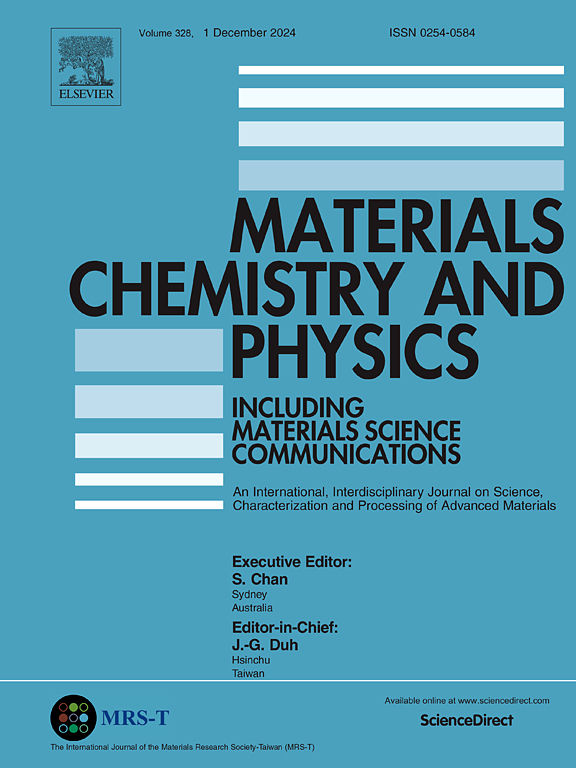Bifunctional electrocatalyst based on Cu/Ce MOFs-derived mesoporous Ce doped Cu/CuO nanorods supported on the oaks-derived activated carbon particles for overall water splitting
IF 4.7
3区 材料科学
Q2 MATERIALS SCIENCE, MULTIDISCIPLINARY
引用次数: 0
Abstract
The development of a cheap and high-performance electrocatalyst that can drive both O2 and H2 evolution reactions (OER and HER) is of great importance, which remains a great challenge. In this regard, the Cu-based electrocatalysts are less reported for overall water splitting. Herein, a bifunctional electrocatalyst was fabricated based on a three-dimensional porous Ce doped Cu/CuO nanorods supported on as-prepared oaks-derived activated carbon particles. At first, the oaks-derived activated carbon particles were prepared via a facile carbonization and activation of oak fruit shells, then, the Cu/Ce MOFs precursor was grown on the as-prepared oaks-derived activated carbon (AC) particles via a facile hydrothermal method. Then, it entirely converted to the MOFs-derived Ce doped Cu/CuO supported on the surface of oaks-derived AC particles (Ce doped Cu/CuO@AC). Remarkably, due to the specific engineering of electronic structure and unique mesoporous structure, fast electron/mass transport, and effective gas releasing, the resulting Ce doped Cu/CuO@AC electrocatalysts offers superb OER performance as well as effective HER activity in the alkaline medium. Moreover, a symmetric two electrode water splitting electrolyzer based on Ce doped Cu/CuO@AC carbon felt electrodes deliver a current density of 10 mA cm−2 at a cell voltage as low as 1.51 V. This study provides a new approach to enhance the bifunctional catalytic activity of Cu based nanostructures for overall water splitting with significant potential for low cost and highly efficient H2 production.
基于Cu/Ce mofs衍生介孔Ce掺杂Cu/CuO纳米棒的双功能电催化剂,支持橡树衍生活性炭颗粒进行整体水分解
开发一种既能驱动O2和H2进化反应(OER和HER)的廉价、高性能电催化剂是非常重要的,这仍然是一个巨大的挑战。在这方面,铜基电催化剂对整体水分解的报道较少。本文以三维多孔Ce掺杂Cu/CuO纳米棒为载体,在制备好的橡树源活性炭颗粒上制备了双功能电催化剂。首先,通过橡树果壳的易炭化活化法制备橡树源活性炭颗粒,然后通过易热法在橡树源活性炭颗粒上生长Cu/Ce mof前驱体。然后,它完全转化为mofs衍生的Ce掺杂Cu/CuO支撑在橡树衍生的AC粒子表面(Ce掺杂Cu/CuO@AC)。值得注意的是,由于特殊的工程电子结构和独特的介孔结构、快速的电子/质量传递和有效的气体释放,Ce掺杂Cu/CuO@AC电催化剂在碱性介质中具有优异的OER性能和有效的HER活性。此外,基于Ce掺杂Cu/CuO@AC碳毡电极的对称双电极水分解电解槽在低至1.51 V的电池电压下可提供10 mA cm - 2的电流密度。该研究为提高铜基纳米结构的双功能催化活性提供了一种新的方法,具有低成本和高效制氢的巨大潜力。
本文章由计算机程序翻译,如有差异,请以英文原文为准。
求助全文
约1分钟内获得全文
求助全文
来源期刊

Materials Chemistry and Physics
工程技术-材料科学:综合
CiteScore
8.70
自引率
4.30%
发文量
1515
审稿时长
69 days
期刊介绍:
Materials Chemistry and Physics is devoted to short communications, full-length research papers and feature articles on interrelationships among structure, properties, processing and performance of materials. The Editors welcome manuscripts on thin films, surface and interface science, materials degradation and reliability, metallurgy, semiconductors and optoelectronic materials, fine ceramics, magnetics, superconductors, specialty polymers, nano-materials and composite materials.
 求助内容:
求助内容: 应助结果提醒方式:
应助结果提醒方式:


